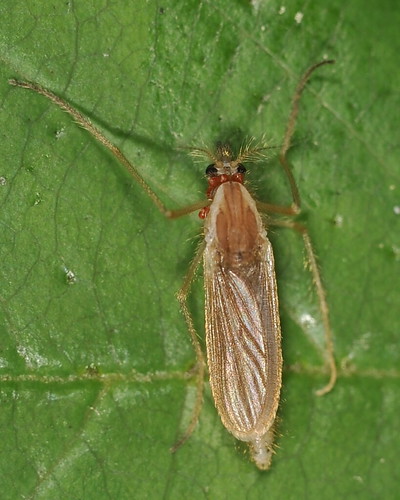Diptera.info :: Identification queries :: Diptera (adults)
Who is here? 1 guest(s)
|
Chaoboridae Chaoborus sp.
|
|
| blowave |
Posted on 15-04-2011 19:20
|
|
Member Location: LINCOLN, UK Posts: 3151 Joined: 27.06.07 |
Hi! I know these are difficult to get to species from photos but I will try.  14th April, on my door on a cold dull day, near Lincoln UK. Size was maybe 7-8mm From searching the site I have found that Chaoborus pallidus has rings on the femora and tibia, I can't see anything obvious on the tibia but there appears to be rings near the apex of the femora. http://diptera.in...#post_6417 We only have 4 species, C. crystallinus; flavicans; obscuripes; pallidus Colour would rule out C. crystallinus, and if the rings are actually rings then it seem it would be C. pallidus. Can anyone say for sure? Janet 
blowave attached the following image:  [95.81Kb] Edited by blowave on 15-04-2011 19:21 http://cubits.org... |
| blowave |
Posted on 15-04-2011 19:21
|
|
Member Location: LINCOLN, UK Posts: 3151 Joined: 27.06.07 |
pic 2
blowave attached the following image:  [94.35Kb] http://cubits.org... |
| blowave |
Posted on 15-04-2011 19:22
|
|
Member Location: LINCOLN, UK Posts: 3151 Joined: 27.06.07 |
pic 3
blowave attached the following image:  [116.38Kb] http://cubits.org... |
| blowave |
Posted on 15-04-2011 19:22
|
|
Member Location: LINCOLN, UK Posts: 3151 Joined: 27.06.07 |
pic 4
blowave attached the following image:  [79.73Kb] http://cubits.org... |
| blowave |
Posted on 15-04-2011 19:23
|
|
Member Location: LINCOLN, UK Posts: 3151 Joined: 27.06.07 |
Rings on femora?
blowave attached the following image:  [73.18Kb] http://cubits.org... |
| empeejay |
Posted on 17-04-2011 09:23
|
|
Member Location: Posts: 234 Joined: 15.05.06 |
It's definitely not pallidus. I'm not sure why you are excluding crystallinus though.
empeejay attached the following image:  [145.54Kb] Edited by empeejay on 17-04-2011 09:31 |
|
|
|
| Sara21392 |
Posted on 17-04-2011 10:43
|
|
Member Location: Posts: 1445 Joined: 07.11.10 |
Wow, last picture is very very nice...! 
Sincerely yours Sara |
|
|
|
| blowave |
Posted on 17-04-2011 14:11
|
|
Member Location: LINCOLN, UK Posts: 3151 Joined: 27.06.07 |
Now that's what I call rings!   I was only discounting crystallinus because on the link with Nikita's he had said: Abdomen unicolor, dark grey, f unicolor - Ch. crystallinus
http://cubits.org... |
| empeejay |
Posted on 17-04-2011 18:57
|
|
Member Location: Posts: 234 Joined: 15.05.06 |
That's right, crystallinus has the abdomen uniformly dark and unbanded with the femora unicolorous, not darkened apically. In flavicans and obscuripes the abdomen appears at least partly light and dark banded. The femora are blackish apically only in obscuripes. blowave wrote: Now that's what I call rings!   I was only discounting crystallinus because on the link with Nikita's he had said: Abdomen unicolor, dark grey, f unicolor - Ch. crystallinus |
|
|
|
| blowave |
Posted on 17-04-2011 21:45
|
|
Member Location: LINCOLN, UK Posts: 3151 Joined: 27.06.07 |
empeejay wrote: That's right, crystallinus has the abdomen uniformly dark and unbanded with the femora unicolorous, not darkened apically. In flavicans and obscuripes the abdomen appears at least partly light and dark banded. The femora are blackish apically only in obscuripes. Thanks for this information! In your opinion, are the femora on this blackish apically? There appears to be a dark ring near the apex. http://cubits.org... |
| John Carr |
Posted on 17-04-2011 22:37
|
|
Member Location: Massachusetts, USA Posts: 10171 Joined: 22.10.10 |
This is somewhat darker than my local species which I believe to be C. flavicans. |
| blowave |
Posted on 17-04-2011 23:01
|
|
Member Location: LINCOLN, UK Posts: 3151 Joined: 27.06.07 |
John, I had looked these up on bugguide and I agree that flavicans is likely to be a yellowish colour. Anything with a species name with 'flava' 'flavipes' etc. in it usually suggests yellow. I got a male yesterday too! It is a little different, but the femora look darkened at the apex. Could this be the same species as the female? blowave attached the following image:  [143.01Kb] http://cubits.org... |
| blowave |
Posted on 17-04-2011 23:02
|
|
Member Location: LINCOLN, UK Posts: 3151 Joined: 27.06.07 |
side..
blowave attached the following image:  [146.41Kb] http://cubits.org... |
| blowave |
Posted on 17-04-2011 23:03
|
|
Member Location: LINCOLN, UK Posts: 3151 Joined: 27.06.07 |
crop
blowave attached the following image:  [125.88Kb] http://cubits.org... |
| John Carr |
Posted on 18-04-2011 02:28
|
|
Member Location: Massachusetts, USA Posts: 10171 Joined: 22.10.10 |
I have seen both yellow-brown and gray males in the same location as yellow females. I assumed the two colors were different species but couldn't identify the gray male. I need to find a copy of Saether's revision. |
| empeejay |
Posted on 18-04-2011 14:57
|
|
Member Location: Posts: 234 Joined: 15.05.06 |
Most of the important bits of Saether's key to the North European species were posted a while back in this thread. The figures of the penis valves are included in Volume 6, Part 2 of Key to the Insects of Russian Far East, which is available online. The colour characters used in the old keys, such as those of Edwards and Freeman, may be unreliable. Having said that, I still think Janet's pictures are most likely crystallinus. The tergites are uniformly dark and the femora are not obviously darker at the apex. |
|
|
|
| blowave |
Posted on 18-04-2011 22:38
|
|
Member Location: LINCOLN, UK Posts: 3151 Joined: 27.06.07 |
Thanks for the probable ID! For now I will call it Chaoborus cf. crystallinus for my records, and the information along with photos of different species is in this one thread for future reference which is great! 
http://cubits.org... |
| Jump to Forum: |














